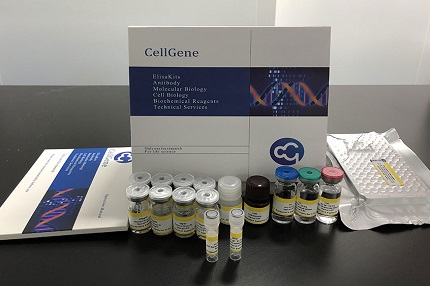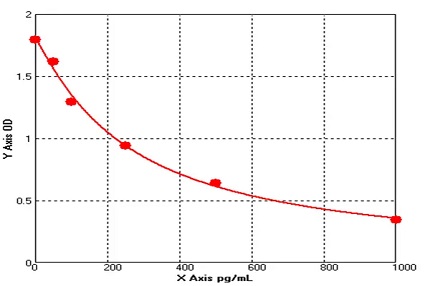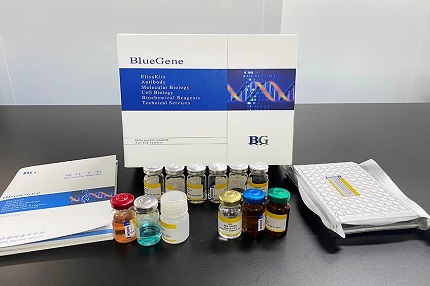E02T0069 Rat Toll Like Receptor4 ELISA kit
The Rat Toll Like Receptor4 ELISA kit can be used to identify samples from the rat species. Toll Like Receptor4 can also be called TLR4, ARMD10, CD284, TLR-4, TOLL, toll like receptor 4.


E02T0069 Rat Toll Like Receptor4 ELISA kit
The Rat Toll Like Receptor4 ELISA kit can be used to identify samples from the rat species. Toll Like Receptor4 can also be called TLR4, ARMD10, CD284, TLR-4, TOLL, toll like receptor 4.
Product Information | |
Cat. No. | E02T0069 |
Product Name | Rat Toll Like Receptor4 ELISA kit |
Species | Rat |
Product Size | 48 Tests / 96 Tests |
Concentration | 1.0-25 ng/mL |
Sensitivity | 0.1ng/ml |
Principal | Competitive ELISA |
Sample Volume | 100 ul |
Sample Type | Serum, plasma, cell culture supernatants, body fluid and tissue homogenate |
Assay Time | 90 minutes |
Platform | Microplate Reader |
Conjugate | HRP |
Detection Method | Colorimetric |
Storage | 2-8°C |
Kit Components | ||
MATERIALS | SPECIFICATION | QUANTITY |
MICROTITER PLATE | 96 wells | stripwell |
ENZYME CONJUGATE | 6.0 mL | 1 vial |
STANDARD A (0.5mL) | 0 ng/mL | 1 vial |
STANDARD B (0.5mL) | 1.0 ng/mL | 1 vial |
STANDARD C (0.5mL) | 2.5 ng/mL | 1 vial |
STANDARD D (0.5mL) | 5.0 ng/mL | 1 vial |
STANDARD E (0.5mL) | 10 ng/mL | 1 vial |
STANDARD F (0.5mL) | 25 ng/mL | 1 vial |
SUBSTRATE A | 6 mL | 1 vial |
SUBSTRATE B | 6 mL | 1 vial |
STOP SOLUTION | 6 mL | 1 vial |
WASH SOLUTION (100 x) | 10 mL | 1 vial |
BALANCE SOLUTION | 3 mL | 1 vial |
Principle of the Assay |
TLR4 ELISA kit uses an anti-TLR4 antibody and an TLR4-HRP conjugate in a competitive enzyme immunoassay method. TLR4-HRP conjugate is incubated with the assay sample and buffer in a pre-coated plate for one hour. The wells are decanted and washed five times when the incubation period is over. The HRP enzyme substrate is then incubated in the wells. The result of the enzyme-substrate reaction is a complex that is blue in hue. The process is finally stopped by adding a stop solution, causing the solution to turn yellow. In a microplate reader, the color intensity is measured spectrophotometrically at 450 nm. Due to competition for the anti-TLR4 antibody binding site between TLR4 from samples and TLR4-HRP conjugate, the intensity of the color is inversely proportional to the concentration of TLR4. Since the number of sites is limited, as more sites are occupied by TLR4 from the sample, fewer sites are left to bind TLR4-HRP conjugate. A standard curve is plotted relating the intensity of the color (O.D.) to the concentration of standards. The TLR4 concentration in each sample is interpolated from this standard curve. |
Coefficient of Variance | Intra Variation% <10% | |
Inter Variation% <12% | ||
Recovery | 95-102% | |
Linearity | Diluent Ratio | Range % |
1:2 | 93-105 | |
1:4 | 88-106 | |
1:8 | 86-108 | |
Specificity/Cross-reactivity | No significant cross-reactivity or interference between TLR4 and analogues was observed. | |




E02T0069 has been referenced in the below publications:
The Role of Resolvin D1 on acute reflux esophagitis with DHA intervention in Rats.
Effect of carboxylesterase 1 on stenosis and infl ammatory response in rats after carotid artery injury.
Tranilast ameliorated subchronic silver nanoparticles-induced cerebral toxicity in rats: Effect on TLR4/NLRP3 and Nrf-2.
A novel role of nifuroxazide in attenuation of sepsis-associated acute lung and myocardial injuries; role of TLR4/NLPR3/IL-1β signaling interruption.
Related Bluegene Biotech Products



